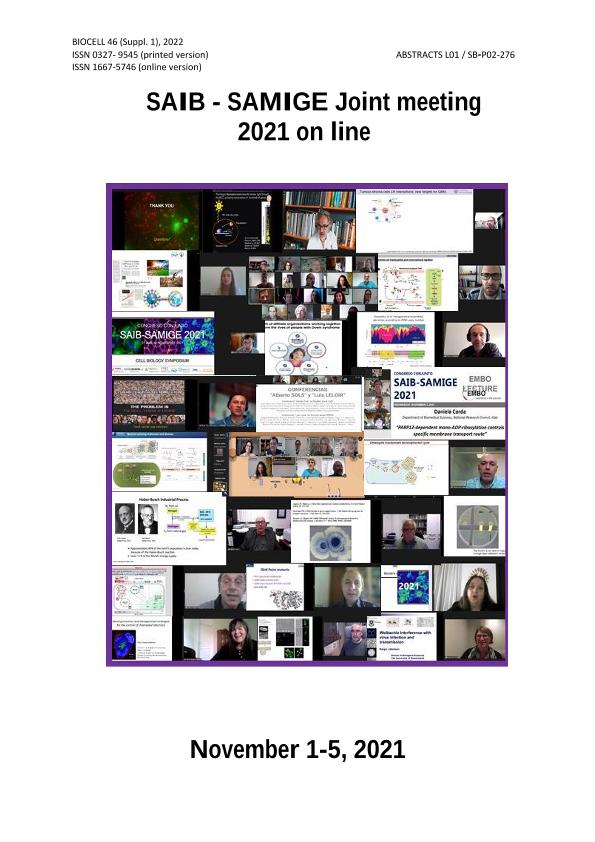Mostrar el registro sencillo del ítem
dc.contributor.author
Costa, M.
dc.contributor.author
de Castro, Rosana Esther

dc.contributor.author
Giménez, M. I.
dc.date.available
2023-11-06T14:31:20Z
dc.date.issued
2022
dc.identifier.citation
Generation and Characterization of H. Volcanii Mutants en Genes with Predicted Roles in Motility and Electron Transfer; Congreso Conjunto SAIB-SAIGE 2021. LVII Annual Meeting of the Argentine Society for Biochemistry and Molecular Biology Research (SAIB). XVI Annual Meeting of the Argentinean Society for General Microbiology (SAMIGE); Argentina; 2021; 113-113
dc.identifier.issn
0327-9545
dc.identifier.uri
http://hdl.handle.net/11336/217137
dc.description.abstract
The halophilic archaeon Haloferax volcanii develops in a wide range of salinities (1.5-3.5 M NaCl) and, due to its ease of cultivation in the laboratory and the possibility of being genetically manipulated, it is used as a model organism for the study of archaeal biology. In the context of a comparative proteomics study of a rhomboid protease (RhoII) gene deletion mutant, we identified several proteins involved in metal homeostasis and cell surface structure/s assembly with differences in concentration and/or electrophoretic mobility in the protease deficient strain. Out of these, some were proteins which had not been previously characterized in H. volcanii, and that may constitute RhoII endogenous substrates. With the aim of understanding their physiological role, two of these annotated proteins (HVO_1153 and HVO_2150) were selected to generate and characterize the corresponding gene knock-out mutants. The hypothetical protein HVO_1153 primary sequence shows homology to adhesins and flagellins, and the hvo_2150 gene encodes HcpG, a predicted small copper protein (similar to plastocyanin and azurin) that may participate in electron transport and/or act as a copper reservoir in the cell membrane of H. volcanii. Genes were removed from the wild type chromosome by the ?pop-in / pop-out" method and the deletion in the null mutants was confirmed by PCR. The successful generation of the null mutant strains indicated that these genes are not essential for H. volcanii viability. The Δhvo_1153 mutant evidenced no differences in cell/colony morphology, cell adhesion to glass surfaces or growth in liquid medium at different conditions, when compared to the wild type strain. However, this mutant strain showed decreased motility in soft agar plates, in agreement with its predicted function in the databases. The ∆hcpGmutant did not exhibit deficiencies in growth in rich or minimal medium, when compared with the wild strain. Further phenotypic characterization of H. volcanii ∆hcpG is still ongoing. Altogether, the results presented in this work provide information regarding the role of two proteins which had not been previously characterized in H. volcanii and contribute to the general understanding of haloarchaeal physiology. Funded by ANPCyT and UNMdP.
dc.format
application/pdf
dc.language.iso
eng
dc.publisher
SAIB SAMIGE
dc.rights
info:eu-repo/semantics/openAccess
dc.rights.uri
https://creativecommons.org/licenses/by-nc-sa/2.5/ar/
dc.subject
HALOFERAX
dc.subject
MUTANTS
dc.subject
MOTILITY
dc.subject.classification
Biología Celular, Microbiología

dc.subject.classification
Ciencias Biológicas

dc.subject.classification
CIENCIAS NATURALES Y EXACTAS

dc.title
Generation and Characterization of H. Volcanii Mutants en Genes with Predicted Roles in Motility and Electron Transfer
dc.type
info:eu-repo/semantics/publishedVersion
dc.type
info:eu-repo/semantics/conferenceObject
dc.type
info:ar-repo/semantics/documento de conferencia
dc.date.updated
2022-11-09T17:28:07Z
dc.identifier.eissn
1667-5746
dc.journal.volume
46
dc.journal.number
1
dc.journal.pagination
113-113
dc.journal.pais
Estados Unidos

dc.journal.ciudad
Henderson
dc.description.fil
Fil: Costa, M.. Consejo Nacional de Investigaciones Científicas y Técnicas. Centro Científico Tecnológico Conicet - Mar del Plata. Instituto de Investigaciones Biológicas. Universidad Nacional de Mar del Plata. Facultad de Ciencias Exactas y Naturales. Instituto de Investigaciones Biológicas; Argentina
dc.description.fil
Fil: de Castro, Rosana Esther. Consejo Nacional de Investigaciones Científicas y Técnicas. Centro Científico Tecnológico Conicet - Mar del Plata. Instituto de Investigaciones Biológicas. Universidad Nacional de Mar del Plata. Facultad de Ciencias Exactas y Naturales. Instituto de Investigaciones Biológicas; Argentina
dc.description.fil
Fil: Giménez, M. I.. Consejo Nacional de Investigaciones Científicas y Técnicas. Centro Científico Tecnológico Conicet - Mar del Plata. Instituto de Investigaciones Biológicas. Universidad Nacional de Mar del Plata. Facultad de Ciencias Exactas y Naturales. Instituto de Investigaciones Biológicas; Argentina
dc.relation.alternativeid
info:eu-repo/semantics/altIdentifier/url/https://www.saib.org.ar/sites/default/files/TSP_BIOCELL_46213-SAIB-SAMIGE%202021.pdf
dc.conicet.rol
Autor

dc.conicet.rol
Autor

dc.conicet.rol
Autor

dc.coverage
Nacional
dc.type.subtype
Congreso
dc.description.nombreEvento
Congreso Conjunto SAIB-SAIGE 2021. LVII Annual Meeting of the Argentine Society for Biochemistry and Molecular Biology Research (SAIB). XVI Annual Meeting of the Argentinean Society for General Microbiology (SAMIGE)
dc.date.evento
2021-11-01
dc.description.paisEvento
Argentina

dc.type.publicacion
Journal
dc.description.institucionOrganizadora
Sociedad Argentina de Investigaciones en Bioquímica y Biología Molecular
dc.description.institucionOrganizadora
Sociedad Argentina de Microbiología General
dc.source.revista
Biocell

dc.date.eventoHasta
2021-11-05
dc.type
Congreso
Archivos asociados
